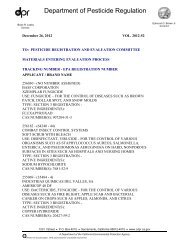Dichlorvos (DDVP) Risk Characterization Document - California ...
Dichlorvos (DDVP) Risk Characterization Document - California ...
Dichlorvos (DDVP) Risk Characterization Document - California ...
Create successful ePaper yourself
Turn your PDF publications into a flip-book with our unique Google optimized e-Paper software.
treatment. No neuropathologic lesions were observed. The LOEL was 5 mg/kg based on reduction of<br />
spinal cord ChE, and brain and spinal cord neurotoxic esterase activities.<br />
Inhalation - Rat<br />
Male rats (strain not specified, number of rats used unspecified) were exposed to <strong>DDVP</strong> (purity not<br />
specified; at nominal concentrations of 0.05 to 90 ug/L) for 4 hours (Blair et al., 1975). Mild signs of<br />
intoxication (lethargy and pupillary constriction) were observed in the 90 ug/L group. The NOEL for<br />
cholinergic signs was 50 ug/L (adjusted dosage of 8 mg/kg-day).<br />
Inhalation - Monkey<br />
Two experiments were conducted with rhesus and cynomolgus monkeys exposed to warehouses<br />
treated with <strong>DDVP</strong> applied as an aerosol (Durham et al., 1959). In the first experiments, monkeys<br />
(2/dose) were exposed to <strong>DDVP</strong>-treated warehouses (0, 0.5, 1.0, or 2.0 mg/ft 3 ) 24 hours after<br />
treatment. The measured air concentrations showed that <strong>DDVP</strong> levels declined with time. For 2.0<br />
mg/ft 3 , the peak level was 2.2 mg/ft 3 and declined to 0.14 mg/ft 3 and 0.07 mg/ft 3 after 24 and 72 hours,<br />
respectively. In the second experiment, monkeys (2/dose) were placed in warehouses to be treated<br />
with <strong>DDVP</strong> at 1.0 or 2.0 mg/ft 3 twice a week for 6 weeks. The monkeys were removed from the<br />
treatment area prior to application and returned 12 hours after application. In the first experiment,<br />
because the baseline levels of plasma and erythrocyte ChE were variable for each monkey and<br />
between monkeys, no treatment related effects were detected. In the second experiment with multiple<br />
applications and longer duration of exposure, a dose-related decrease in the plasma and erythrocyte<br />
ChE activities was observed after 50 days of exposure (data were presented only in graphs). After<br />
removal from exposure, the activities of both plasma and erythrocyte ChE recovered toward baseline<br />
levels.<br />
Inhalation - Human<br />
In several human studies, brief continuous exposures to <strong>DDVP</strong> aerosol up to 10 mg/ft 3 (3.5 mg/L)<br />
either generated by no-pest strips or solution left for evaporation did not result in statistically<br />
significant inhibition of plasma or erythrocyte ChE activities (Durham et al., 1959; Shell Chemical Co.,<br />
1965).<br />
In a study conducted with <strong>DDVP</strong> resin strips (1 strip/30 m 3 , Vapona Strips) in a hospital, the effects<br />
of <strong>DDVP</strong> exposure on 125 patients (men with and without liver disease, women during labor and<br />
postpartum, and sick children) were studied (Cavagna et al., 1969). After 24 hours of exposure,<br />
plasma ChE activity of the women was not affected while the activity for the other groups were<br />
inhibited. The extent of the inhibition, expressed as percent of control values, for <strong>DDVP</strong> air<br />
concentrations of 0.1-0.28 mg/m 3 were 28-65% for men without liver disease, 35-67% for men with<br />
liver disease, and 55-92% for children. For <strong>DDVP</strong> air concentrations of 0.02-0.1 mg/m 3 after 16 hours<br />
of exposure, only the plasma ChE activity of the men with liver disease was lowered (35-57% of<br />
control values). Based on the estimated <strong>DDVP</strong> intake per day from the report and the DPR default<br />
body weights of 55 kg for adults and 10 kg for children, the NOEL for plasma ChE inhibition was 0.014<br />
mg/kg-day for children, 0.02 mg/kg-day for men without liver disease, and 0.026 mg/kg-day for<br />
women. Since men with liver disease were affected by both levels of <strong>DDVP</strong>, the LOEL was 0.006<br />
mg/kg-day. There was no effect on erythrocyte ChE activity.<br />
In another hospital study, new-born babies (22) were exposed to <strong>DDVP</strong> (1 strip/30 to 40 m 3 ,<br />
Vapona Strips) released from resin strips with a time-weighted average air concentration of 0.15<br />
ug/L for 18 hours per day for 5 days (Cavagna et al., 1970). No significant depression of plasma and<br />
erythrocyte ChE activities was found. The estimated daily dose was 0.07 mg/kg-day assuming a<br />
respiratory rate of 0.46 m 3 /kg-day.<br />
17
















